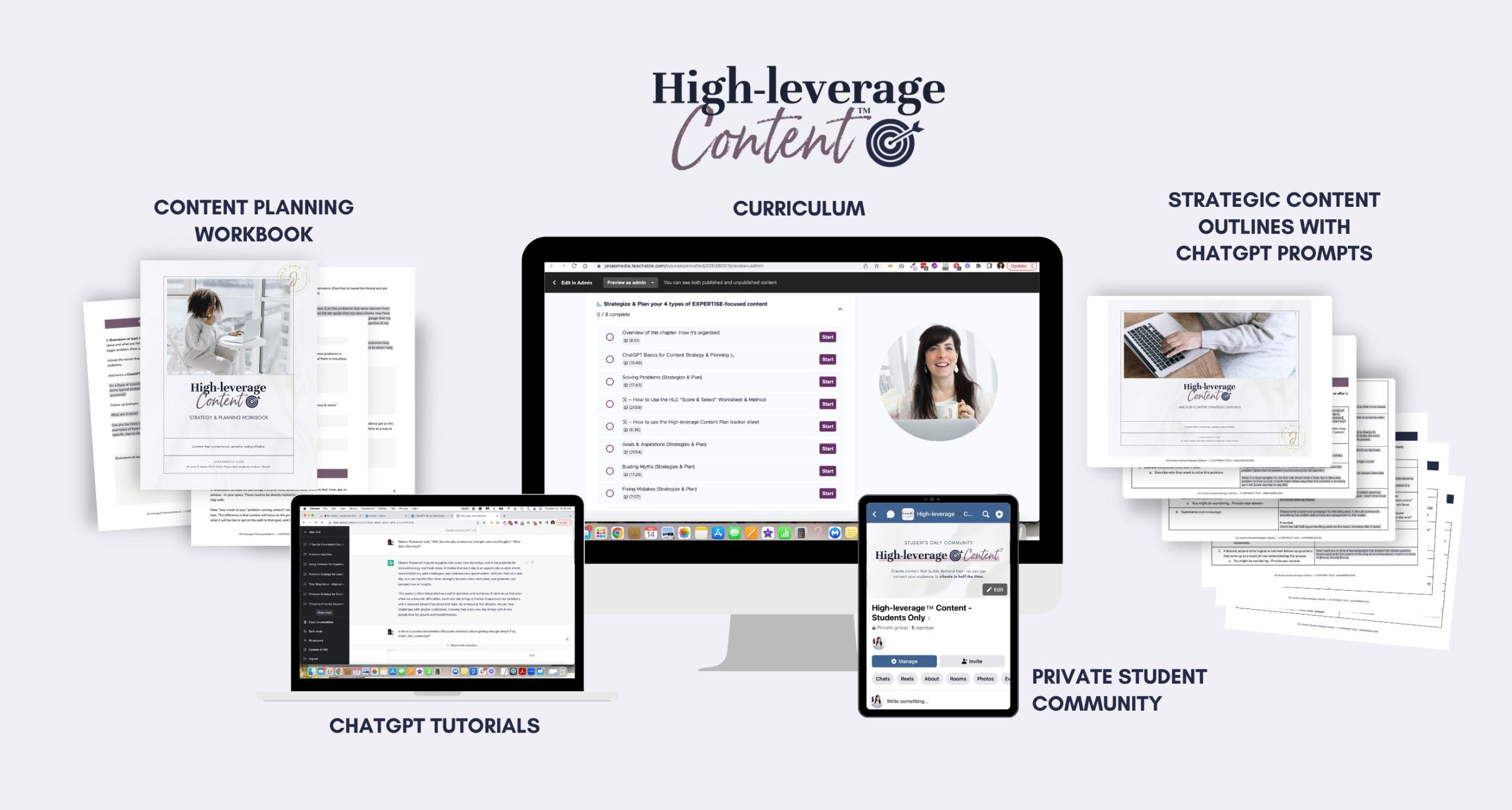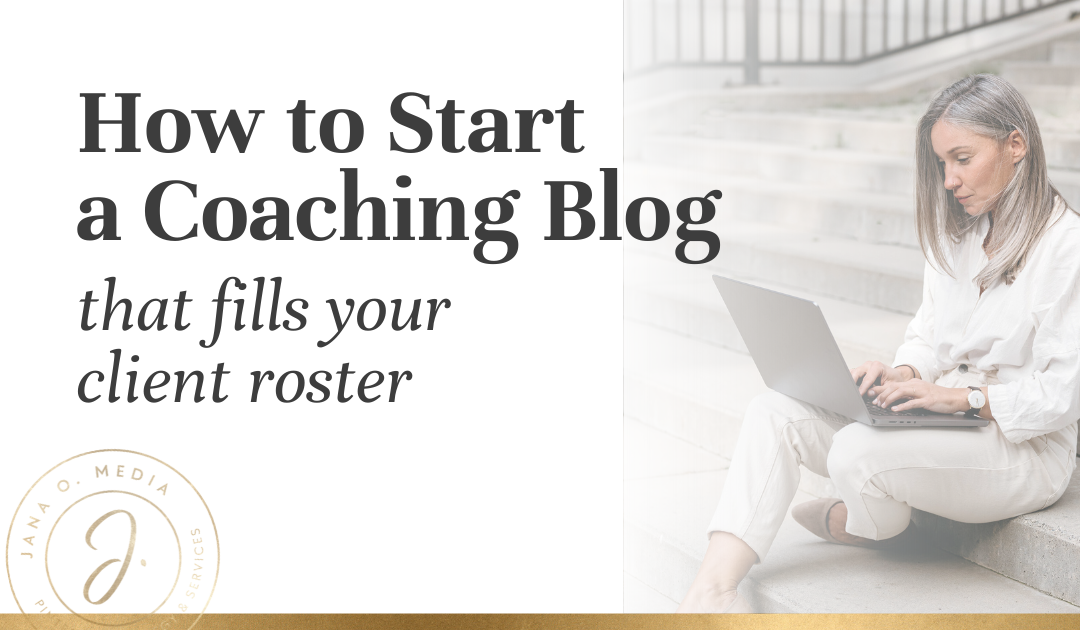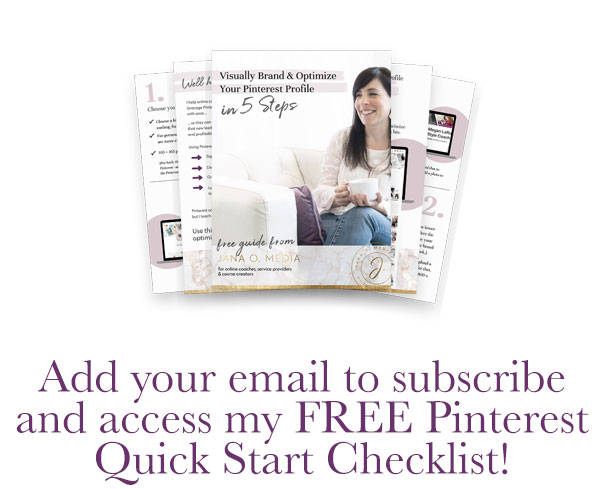So, you want to start a life coach blog? And you want it to fill your client roster with dreamy clients who are ready to do the weeeerrrk and make real changes?
Well, as Alexis Rose says on Schitt’s Creek…… “I love that for you!”
Publishing a small-but-mighty, strategic, suite of blog posts has soooo many benefits for an online coach. Here’s just a few:
✔️ It establishes you as an authority in your niche.
✔️ It quickly builds trust and rapport with people who are considering signing with you
✔️ It’s a rich mine of content to repurpose and remix over and over — across social media, newsletters, speaking engagements, and any other marketing channels
✔️ It increases your digital footprint, making you more visible and accessible to those looking for what you help with
And maybe most importantly…
With the right strategy, a blog increases your conversions — helping people go *quickly* from “Hey, I just met you!” to “Can I give you my credit card?”
Awesome, right? 💪🏼
Right.
Okay but… The question now is… Where and how do you start?
In this blog post, I’m providing a comprehensive guide to How *EXACTLY* to Start a Life Coaching Blog. And I’m organizing this guide into…
5 Steps to Start Your Coaching Blog:
Here’s what I’m covering…
Okay… I am busting at the seams excited to share all this with you. So let’s dive right in. We shall start at the beginning, when you…
1. Be very clear on how you will monetize your coaching blog.
As a coach, your goal is to build a blog that becomes a powerful tool to attract and convert coaching clients.
That 👆🏻👆🏻👆🏻 is how you will monetize your blog.
In other words:
Your goal is to get clients, not to be a “blogger.”
Understanding this — and proceeding accordingly — will save you so much confusion, content burnout, and wasted time down irrelevant rabbit holes, trust me!
Now, let me explain why I’m so adamant about this…
For traditional “bloggers,” their blog IS their full-time job. These folks typically grind away, 50-60+ hours a week.
They’re trying to get their websites qualified for networks that pay them to place ads on their blogs.
They’re adding affiliate links that pay pennies for any purchases. (Their plan is to stack up hundreds of those small sales… all to earn what you will earn when you sign ONE coaching client.)
As a coach, your blog will NOT be your full-time job. You will NOT need to spend all your waking hours blogging. (Your full-time job is working with clients!)
And when future clients read your blog posts, they won’t see a bunch of ads or affiliate links.
Instead, they will read your strategic, thought leadership content. Content that is designed to build demand for your offers, and trust in you as an expert. (More on that below in #3!)
(Note: I’m not knocking the traditional blogging route—it works for some. But as coaches, that’s not our bread and butter.)
So, bottom line:
Get clear on the fact that your “monetization method” for your coaching blog is to get paying coach clients.
And don’t get distracted by advice that is not meant for your business model.
Because if you wander down the “traditional blogger” path, focusing on things like affiliate links and chasing traffic with crazy SEO tactics, you’re setting yourself up for a world of confusion and burnout. And let’s be honest, that’s the last thing we want!
Our goal? To keep your blogging laser-focused on what really matters for your business – blogging for clients who are ready to jump on board and work with you to create change.
So let’s keep our eye on the prize! … Okay, next up…
2. Choose where you will post your coaching blog.
If you already have a website for your business, the best option is usually just to add a blog to your site, on the platform you’re on now.
Most major website platforms (including WordPress, Squarespace, Wix, Kajabi… all of them!) have a blog feature.
And one of the benefits of having a blog FOR your business, not AS a business (As described in in #1 above!) is this:
You don’t need lots of bells and whistles on your blog. You just need a straightforward, user-friendly way to add the thought leadership pieces that your future clients need to read to be ready to sign with you.
(So that means: Don’t get caught up worrying about blog categories or fancy headers or anything like that just yet. Just get a basic blog up and start publishing asap!)
Now… If you don’t have a website yet, then picking the right platform (for your website and blog) is really about finding a balance between ease of use and the flexibility to grow and evolve with your business.
To choose between platforms like WordPress, Squarespace, Wix, Kajabi, and others, you can consider these factors:
- Your Tech Comfort Level: Platforms like WordPress offer immense customization, but they can be a bit daunting if you’re not tech-savvy. On the flip side, Squarespace and Wix are more user-friendly, offering drag-and-drop interfaces, but they may limit some advanced customization.
- Your Growth Plans: Think about where you see your blog in the next few years. WordPress, with its vast array of plugins and themes, is great for scalability. If your needs are simpler and you prefer a more straightforward, stylish approach, Squarespace or Wix could be your go-to.
- Your Budget: While platforms like Wix and Squarespace have straightforward pricing, WordPress might require additional costs for themes, plugins, or hosting services. Weigh your initial investment against potential long-term benefits.
While we’re answering the question of “where to put your blog,” I do want to address a question I get a lot… “What about external blog platforms, like Medium or Substack, for example?”
(Platforms that don’t live on your domain / your website.)
And bottom line is this: I recommend against them.
It’s my belief that your blog needs to be on your website for the most effective, sustainable ‘blog as marketing’ strategy. Here’s why:
- Control and Ownership: Hosting your blog on your website gives you complete control over your content and branding. Unlike external platforms like Medium or Substack, you’re not subject to their rules, algorithms, or design limitations.
- Long-Term Asset: Consider your blog on your website as a long-term asset. Platforms like Medium can change their policies, affecting your visibility and monetization. Your website remains your digital property, a consistent platform for your thought leadership.
- A ‘One-Stop Shop” is best for Conversion: Your website acts as your brand’s hub. Visitors can not only engage with your blog but also join your email list, explore your services, testimonials, and other offerings — right there on your site. So, this integration is crucial for converting readers into clients… which is our #1 goal here.
- SEO Benefits: While I do NOT recommend that you worry about SEO when you first start your blog, there can be SEO benefits *down the road*, when you put your blog on your own website.

So yes… Hosting your blog on your own website is a strategic move, empowering you with control, allowing readers to easily explore your offers and join your email list, and ensuring long-term stability in your online presence.
Okay, once you have a *simple* blog set up, it’s time to answer the question:
What should I blog about as a life coach?
Big question, right? Well don’t worry, I totally have you covered. There are really two pieces to the answer, and I’ll cover them in Sections #3 and #4 below.
Let’s dive in…
(Pssssst…. You can 📌 pin this article for reference to your “Coaching Business” board:)

3. Strategize and plan your first set of blog posts.
The biggest mistake 😑 I see coaches make with their blogs? It’s when they simply start writing — without thinking about what TYPES of posts will actually convert their readers to coaching clients.
So before you start writing randomly, it’s crucial to get really intentional — and plan a content strategy for your blog.
We want your posts to really work hard for you. We want them to truly represent your unique thought leadership. And we want them to build demand for your paid offers — and build your readers’ trust in you as the go-to expert.
For that, you need a real strategy.
Inside High-leverage Content, my signature system and course, I teach ‘9-in-2’ Content Pillars strategy.
This system works for all types of long-form content (blog posts included!) when the goal of that content is to book discovery calls and clients.
These 9 pillars are based on the things that future coaching clients need to hear, learn, and understand — to be ready to hire you.
So my recommendation here in Step #3 is to follow this process. 👇🏼👇🏼👇🏼
(1) Brainstorm at least 10 topic ideas in each of the 9 categories:
Use your knowledge of your ideal audience’s problems, desires, interests, etc. You can also use outside tools* to help you brainstorm.
(*For example, inside HLC I teach you how to use ChatGPT to think out of the box and come up with topic ideas that you might otherwise not think of or consider. AI can be a powerful ally in coming up with the most profitable topics for your blog!)
(2) Evaluate all your topic ideas on three key factors:
Alignment, Relevance; and Ease.
These three factors make up the ARE framework I teach inside High-leverage Content. You can read more about that framework in this blog post. But the Reader’s Digest version is this:
🎯 Alignment is about how closely your content is related to your paid offer(s).
🎯 Relevance is whether (or not) your future clients care about what you’re saying.
🎯 Ease is how easy it is for *you* to get detailed on this topic.
(3) Select the best, most profitable blog post topics:
Your time is precious! I don’t want you to write 1,458 blog posts before you finally figure out which ones will convert your audience to clients. So I highly recommend that you be discerning, and use the ARE framework above to pick the *best* topics for your blog.
(4) Put your first 9 topics into a spreadsheet:
This becomes your content plan for your first nine posts! Boom. You’ve got a multi-month plan for blog posts that will build demand for your paid offers, and trust in you as an expert.
And now (finally, right? 🤣) it’s time to write your posts and get them out into the world… Which leads us to Section #4:
4. Write and publish coaching blog content.
With your topics selected, you may be thinking, “Sooooo… How do you write a coaching blog?”
This is where the rubber meets the road, and admittedly, it can feel a little overwhelming — if you let it.
But if you have a good process to follow, you can knock out high-quality posts quickly. (And it sure helps a lot that you’ve already selected your topics.)
I teach a 4-Step “Logical & Light” writing process that breaks down each part of the writing, so it feels less overwhelming — and it ensures you’ll end up with a high-quality post.
The 4 Steps are:
- Outline your post.
- Draft each section of your post.
- Flesh out your post (with examples, thought leadership insights, etc)
- Refine your post.
Here are some tips for each step:
- When you outline, think about your own unique philosophies and opinions. What do you want to include? What does your ideal audience need to know about this? Where can you align this with your own coaching framework or process? Doing this will ensure that your post is a reflection of your unique thought leadership — not just something generic that your reader has seen before.
- When you draft, don’t be afraid to ask for a little help from AI writing tools, like ChatGPT. They get a bad wrap for spitting out cookie-cutter gobbly-gook 🤣… But if you already have a strong outline that incorporates your *unique* perspectives, you won’t get generic outlines. (I teach techniques for using ChatGPT inside HLC. They are completely optional, but powerful and time-saving!)
- When you flesh out, you’ll be looking for areas that need more depth, and adding it. You can also look for places to add stories, your own observations, examples, and even fun metaphors… things like that.
- When you refine, you can re-arrange sections, check for spelling and grammar, and transitions where you feel they need to be… So the tip here is really not to worry about those things in the first three steps. You’ll write faster and be more creative if you know you’ll have time later to refine!
Here’s a handy little cheat sheet that summarizes what I covered in Sections #3 and #4:

Okay, one more note about the actual writing process:
So in terms of how to *structure* your blog…
Because your goal is not simply to entertain or educate — but also to write blog posts that will convert your audience to clients… there are some unique considerations.
If you’re a student of High-leverage Content (or if you enroll today!), you can use the system’s plug-and-play Strategic Content Outlines to structure your posts.
These outlines lay out — paragraph by paragraph — what elements to include, to trigger connection, build trust, and create the right “ah-ha moments” that drive sales.

Okay…
Now it’s time to move along and talk about how to…
5. Promote and leverage your coaching blog.
When you pour your expertise and passion into creating a coaching blog, it’s crucial to remember that its visibility goes beyond just regular readership.
Often, your blog serves as a pivotal touchpoint for potential clients who are vetting your services. They check out your blog to gauge your expertise, style, and the value you can offer.
While it’s essential for your posts to be seen by this audience (since you wrote them strategically to convert your audience to clients!) … broadening your reach to new eyes is also important. That’s where promotion plays a key role.
The good news is that there are so many fun strategies to amplify your blog’s visibility! Here are just a few of them:
(1) Send your blog posts out to your email list:
Send them as you write them, sure. But ALSO… Don’t forget to leverage them by including them in your welcome sequence, so anytime a new person signs up, they have the opportunity to read them and move closer to booking and hiring you!
And you can also send them out more than once. I like to send my most high-converting blog posts out to my list once every few months.
(2) Promote your blog posts on social media:
Share them with a twist: Don’t just drop the link. Create engaging posts that tease the content or pose a thought-provoking question or idea related to your blog topic. This strategy can spark curiosity and drive traffic to your blog
(Inside High-leverage Content, I teach two frameworks for easily and quickly sharing your posts: My 💎 ”Gem Pull” method; and my 🥕 “Straight Teaser” method!)
(3) Repurpose and remix your blog posts into other High-leverage assets:
Need a speaking topic for a summit? Need a fresh topic to pitch to appear as a guest on podcasts?
Look no further than your strategic thought leadership content on your blog. It’s a rich reservoir you can go back to, again and again, when you need content for any purpose — including for speaking topics.
This not only saves time because you’re not constantly re-creating the wheel… It also ensures that your message is coherent and consistent across various platforms.
So good, right??? 💥💥💥
So be sure to keep on top of *using* and *sharing* your amazing coaching blog posts…
By strategically promoting and re-mixing them through various channels, you can both reinforce your expertise to current audience *and* captivate new audiences — expanding your influence and potential client base.
Okay, there is ooooooone more thing I want to address, because it might be niggling at you right now. You *might* be thinking…
But… Does anyone even read blogs anymore?
Perhaps you’re reading this blog post, and you’re getting excited about your blog. You’re beyond ready to start sharing your thought leadership with the world, and using it to get booked out with dream coaching clients.
But there’s a little ‘nay-sayer’ voice in your head and she’s saying… Yeah but, does anyone actually read blogs these days?
Well, let me assure you: Yes, people read blogs — when they are relevant to them.
There’s an old copywriting saying from the 60’s. (Howard Gossage said it. Total Mad Men vibes.) He said:
“People don’t read ads. They read what
interests them, and sometimes that’s an ad.”
And THAT is how blogs work, too.
People don’t read random blogs. They don’t just go to the internet thinking, “What random blog can I find today to spend my time reading.” 🤣
But they do read…
✔️ what fascinates them and feels important to them
✔️ what motivates them to work toward a change they *really* want to experience in their life or business
✔️ what they believe will help solve a problem they have
✔️ what will get them closer to something they want badly
And that’s exactly the type of blog posts you’ll learn how to write when you follow the strategy I’ve outlined in this blog post today.
Students inside my High-leverage Content system write blog posts that are fascinating and feel VERY important to their ideal future clients. Blog posts like:
-
- Stuck on the monthly fertility rollercoaster? How to break the cycle now. (from HLC student Becky)
- The #1 reason you’re having no luck with online dating apps (from my past client, Andi)
- How to boost your immunity by beating stress (from HLC student Rachel)
- Yes, you CAN build a brand with more than one ideal client (from my past client, Kaye)
So YES!… With the right content strategy, people will want to read YOUR blog… And it will get those people excited to work with you — and booking and buying.
Start Your Life Coaching Blog with a Proven Step-by-Step Strategy: The High-leverage Content System.
High-leverage Content (HLC) is my system and course for coaches and service providers who want to lean into long-form content — like a blog.
They want a proven, strategic method to follow — to make sure they get ROI from the time and energy they invest it.
🎯 Inside, you’ll plan and create thought leadership content that builds demand fast – and converts your audience to clients in half the time.
On Day 1 inside the curriculum, you’ll learn my famous ‘9-in-2 Content Pillar’ framework (referenced in Step 3 above) — so you know exactly what NINE types of content your audience will need — to be ready to buy.
And you’ll have everything you need — tools and trainings — to easily and systematically write those posts effectively, including:
-
- 9 plug-and-play “HLC Strategic Content Outlines” to guide your writing process
- My ‘Score & Select’ worksheets and training, so you can easily cull through all your ideas and pick the best ones to focus on
- In-depth training on my Logical and Light 4-step writing process for high-converting content.
- Powerful worksheets and checklists to guide your process
… and a lot more! 🙂
Following the High-leverage Content system will ensure that you select the right topics and create blog posts that your ideal future clients WANT to read…
Posts that stop them in their tracks, get them binge-reading like you’re the latest Netflix phenom, and leaping 🏃🏻♀️at the chance to hire you to coach them!




